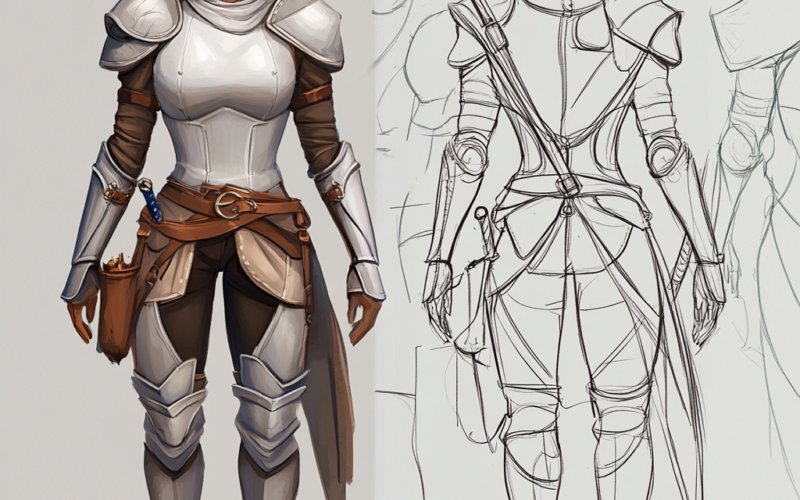Defining a Character Concept
When creating a character for a game, the first and most important step is to define the concept. This includes answering a few key questions that will help form an overall understanding of the character.. You need to understand what role he will play in the game: whether he will be the main character, an antagonist, or a secondary character. It is also important to decide what genre of game and world will surround the character – this will help determine his appearance, characteristics and behavior. For example, a character for a fantasy game will be different from a character for a sci-fi or historical game.
The next step in conceptualization is to work out the character’s motivation and personality. What are his goals, desires, fears? How do his personal qualities affect the plot and interactions with other characters? It is important to consider here that the character’s inner world must be connected to the external circumstances of the game so that players can understand his behavior and make decisions based on this.
Development of appearance and characteristics
Once the concept of the character is determined, the next step is to develop his appearance and characteristics. The appearance should be in harmony with the world of the game and the role of the character. Here it is important to take into account factors such as age, gender, race, profession and status of the character, which directly affect his appearance. For example, if a character is a warrior, his clothing and weapons will correspond to this status. It is also important to create unique traits that will help the character stand out from the rest.
Character characteristics include not only physical characteristics, such as strength, endurance, dexterity, but also social characteristics – for example, charisma, intelligence and other qualities that will affect interactions with other characters and the development of the plot. These characteristics can be visually represented through elements such as facial expressions, postures, or clothing features.
Choosing an illustration style and technique
The choice of illustration style and technique plays a key role in creating a character, since it is the visual component that creates the first impression. The style should match the atmosphere of the game and be in harmony with its design. Games with a cartoon style may feature colorful and eccentric characters, while more serious games such as RPGs or fantasy may favor realistic and detailed images.
Illustration technique is also important to the final look of the character. The choice can be made in favor of traditional drawing, digital art, or mixed techniques. It is important that the technique supports not only the visual appeal, but also the functionality of the character. For example, elements of a costume or weapon should be drawn in such a way that they are clear and easily recognizable to the player in the context of the gameplay.
Creating sketches and sketches
At this stage, the first sketches and sketches are created, which help to visualize the main ideas and concepts of the character. Sketches give you the opportunity to experiment with shapes, poses, facial expressions, and other important elements that will help you better understand what your character will ultimately look like. This stage usually includes several variations that can be revised and refined.
Sketching helps you understand how a character will interact with the world around them, how they will move, and how their appearance will reflect their personality. It is important not only to accurately convey the appearance, but also to include in these sketches the key features of the character that will be revealed during the game. This stage completes the formation of a visual basis for further work.
Detailing and drawing
When the basic elements of the character have already been determined, the detailing stage begins. Here, artists work on every element – textures, light, shadows, small details of clothing, weapons and other accessories. These elements must be drawn in such detail that the character looks organic in the game world and is perceived by players as a living being.
Also at the detailing stage, you can improve the character’s facial expressions so that they accurately match his character and mood. This is an important point in creating a character that is not only functional, but also emotionally invested in the story. The result is a high-quality and unique illustration, which will serve as the basis for further work on introducing the character into the game.
Final processing and preparation for use in the game
After the character is created and all the details are drawn, it is important to carry out the final processing and prepare it for integration into the game. This stage includes several important steps that will ensure the effective use of the character in the gameplay.
- Final Design Review – At this stage, you need to make sure that all the elements of the character look harmonious and that its appearance matches the concept of the game.
- Model optimization – In order for the character to work correctly in the game, it is important to reduce the number of polygons and textures so as not to overload the game engine, while maintaining high quality.
- Animation and Rigging – This step involves creating the character’s bones and joints for animation so that he can move and interact with the game world.
- Testing – Before a character is finally implemented into the game, testing must be carried out to ensure that it displays and functions correctly in various conditions.
- Preparing for Integration – After verification and testing, the character is ready to be integrated into the game. This includes exporting the character into the desired format and handing it over to the development team for implementation into gameplay.
This stage requires care and careful work to ensure that the character not only looks good, but also functions correctly in the game world. Finishing helps prepare a character for its role in the game, ensuring it can be used effectively in a variety of game scenarios and situations.
Questions and answers
Answer 1: The concept of a character involves defining his role in the game, his motivation, his personality, and his connection to the game world.
Answer 2: A character’s appearance depends on his role in the game, age, gender, profession, as well as the world in which he exists.
Answer 3: The style and technique of illustration determine the first impression of the character and should be in harmony with the atmosphere of the game.
Answer 4: Sketches and sketches help you visualize basic ideas and experiment with character shapes and poses.
Answer 5: The detailing stage involves working on textures, lights, shadows and small elements to make the character look organic in the game world.

